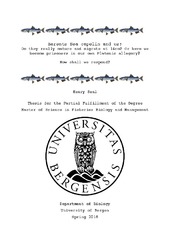| dc.contributor.author | Seal, Henry | |
| dc.date.accessioned | 2018-08-13T16:23:57Z | |
| dc.date.available | 2018-08-13T16:23:57Z | |
| dc.date.issued | 2018-06-15 | |
| dc.date.submitted | 2018-06-14T22:00:11Z | |
| dc.identifier.uri | https://hdl.handle.net/1956/18065 | |
| dc.description.abstract | Capelin (Mallotus Villosus) are an important component of the Barents Sea ecosystem. As zooplankton consumers they play a role in channelling energy up the food web, and they have the potential to represent a biomass of several million tonnes. Their population has undergone booms and crashes, as one may expect of a high production, high mortality species, and our management of the fishery is based around preventing a >5% chance that the spawning stock biomass will fall below 200,000 tonnes. They are surveyed in the autumn, before a maturity model is applied and natural mortality is factored in during their migration to the spawning sites, leaving a total allowable catch (TAC). Our present model is a simple cut off of 14cm, and anything longer is assumed to spawn that year. This may be too simplistic however, as it possibly does not reflect the biological situation on the ground, which could lead to miscalculations of the spawning stock and the accompanying TAC. In this investigation I used the survey data and catch data in a comparison to assess the 14cm cut off, and following this made models which would better reflect the length and age distributions seen in the catch. Its seems likely that the biomass of capelin migrating has been overestimated every year, and that we need to do further work to assess the spawning stock in order to get a better handle on capelin maturity. | en_US |
| dc.language.iso | eng | eng |
| dc.publisher | The University of Bergen | en_US |
| dc.subject | Bestandsanalyse | nob |
| dc.subject | Fiskebestander | nob |
| dc.subject | Fiskeriforskning | nob |
| dc.subject | Fiskeriforvaltning | nob |
| dc.subject | Lodder | nob |
| dc.subject | Barentshavet | nob |
| dc.title | Barents Sea capelin and us; Do they really mature and migrate at 14cm? Or have we become prisoners in our own Platonic allegory? How shall we respond? | en_US |
| dc.type | Master thesis | |
| dc.date.updated | 2018-06-14T22:00:11Z | |
| dc.rights.holder | Copyright the Author. All rights reserved | en_US |
| dc.description.degree | Master's Thesis in Biology | en_US |
| dc.description.localcode | MAMN-BIO | |
| dc.description.localcode | BIO399 | |
| dc.subject.realfagstermer | https://data.ub.uio.no/realfagstermer/c013049 | |
| dc.subject.realfagstermer | https://data.ub.uio.no/realfagstermer/c004185 | |
| dc.subject.realfagstermer | https://data.ub.uio.no/realfagstermer/c004087 | |
| dc.subject.realfagstermer | https://data.ub.uio.no/realfagstermer/c030943 | |
| dc.subject.realfagstermer | https://data.ub.uio.no/realfagstermer/c013664 | |
| dc.subject.realfagstermer | https://data.ub.uio.no/realfagstermer/c013662 | |
| dc.subject.nus | 751999 | eng |
| fs.subjectcode | BIO399 | |
| fs.unitcode | 12-60-0 | |
